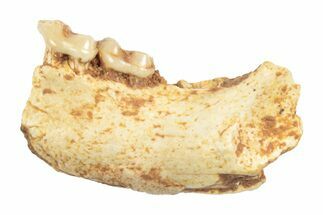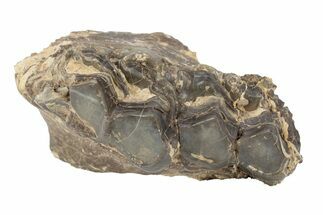This Specimen has been sold.
.27" Eocene Fossil Primate (Pseudoloris) Jaw Section - France
This is a rare, .27" wide jaw section containing one tooth of the Eocene omomyid primate, Pseudoloris parvulum. It was collected from the Quercy Phosphorites Formation of Lot (formerly Quercy), France.
Comes in a display case.
Comes in a display case.
Pseudoloris is an extinct genus of small primates, similar to modern tarsiers. They are some of the earliest members of the family Omomyidae, which includes largely extinct lemurs, tarsiers, and other small primates.
Like modern tarsiers, Pseudoloris had large eyes and were likely nocturnal, feeding on insects or fruit.
Like modern tarsiers, Pseudoloris had large eyes and were likely nocturnal, feeding on insects or fruit.
The Quercy Phosphorites Formation in France is world famous for its Eocene to Miocene faunas, especially those from the upper Eocene to lower Oligocene. The latter particularly helped to understand the ‘Grande Coupure’, a dramatic faunal turnover event that occurred in Europe during the Eocene-Oligocene transition. Fossils from the Quercy Phosphorites were excavated during the mid-19th century until the early 20th century from a series of sites that are no longer accessible. These fossils have subsequently dispersed between several research institutions, unfortunately losing some temporal and geographical information in the process. This material is part of an old collection we acquired that presumably was collected along with this material in the 19th or early 20th century. A recently published paper on the mammals of the Quercy Phosphorites can be found below.
The upper Eocene-Oligocene carnivorous mammals from the Quercy Phosphorites (France) housed in Belgian collections
The upper Eocene-Oligocene carnivorous mammals from the Quercy Phosphorites (France) housed in Belgian collections
SPECIES
Pseudoloris parvulum
LOCATION
Lot (Formerly Quercy), France
FORMATION
Quercy Phosphorites Formation
SIZE
.27" wide
CATEGORY
ITEM
#248715
We guarantee the authenticity of all of our specimens.
 Reviews
Reviews











